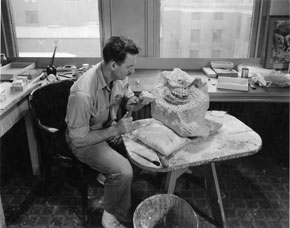Preparation
Removing the matrix during excavation means that fossils are often at least partially visible, but this does not mean they are ready for study or exhibition. Once the fossil arrives back at the museum there is still a lot of work to be done before it can be made available. The field jacket has to be cut away, more matrix may need to be removed, and the specimen may require repair, or more treatment with consolidants to harden and strengthen it. This process is known as preparation.
How much preparation the fossil requires will depend on its condition after excavation and also the goal that the museum or researcher has in mind for its future use. A researcher may want to expose features for identification or further study. They may also want to disarticulate bones that are joined together to make them easier to handle, store, and examine. If the specimen is going to be exhibited, it may be better to leave the bones partially embedded in matrix to provide support, or leave them articulated to give visitors a better sense of the appearance of the animal. Sometimes the matrix will be completely removed and the bones mounted on a supporting armature.
The methods used to prepare fossils depend on the type of bone and matrix. The commonest method is to use tools to mechanically remove rock from around the specimen. Loose matrix can be brushed away, or removed with a hand-held needles. Harder rock may require the use of dental mallets and air scribes, or even a hammer and chisel. For some types of specimens, very dilute acid can be used to dissolve the surrounding matrix, leaving the bone intact. Museums often have specialized laboratories equipped for this sort of work.
Preparation is a highly skilled task; if not done with the wrong techniques, or with insufficient care, it can ruin a specimen beyond repair. For this reason, fossils should only be prepared by someone who understands the specimen, the materials they are working with, and the techniques available to them.


